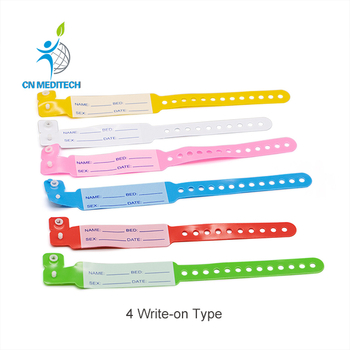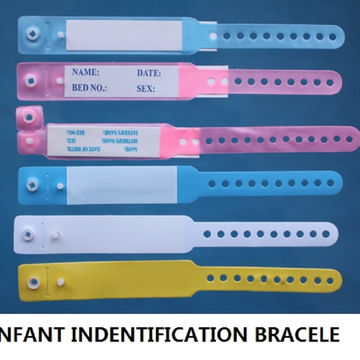Enhancing Patient Treatment With Reliable Recognition Bands
The application of efficient identification bands is a pivotal element in boosting person care within healthcare setups. These bands not only offer to alleviate the risks associated with person misidentification however also streamline interaction amongst clinical workers, therefore fostering a more secure environment. Different kinds of recognition bands cater to certain needs, from resilient wristbands for grownups to specialized bands for infants and essential cases. As the landscape of individual recognition evolves, one need to take into consideration the ramifications of these systems on total health care delivery and individual end results. What innovations wait for in this critical area?
Importance of Client Identification
Making sure precise individual recognition is critical in healthcare settings, as it directly influences the safety and security and quality of care provided. Misidentification can cause serious errors, including providing the wrong drug, performing incorrect treatments, or miscommunicating essential person info. Such errors not only threaten person security however can also result in lawful ramifications and reduced count on in healthcare systems.
Effective person recognition is essential to developing a protected environment where patients obtain ideal and personalized care. It facilitates the exact paperwork of medical backgrounds, allergies, and therapy plans, guaranteeing that healthcare companies have access to crucial info at all times. Robust identification protocols aid improve interaction among clinical staff, improving collaboration and minimizing the threat of mistakes.

Sorts Of Identification Bands
Recognition bands play a crucial function in keeping accurate individual records and improving safety within health care environments. Numerous sorts of recognition bands are utilized to provide to the certain requirements and requirements of various patient populations.

An additional type is the ankle joint band, which is particularly useful for infants and infants, making certain that recognition continues to be intact also during treatment procedures. Specialized bands, such as those for allergy signals or fall threat indications, give additional layers of security by attracting immediate interest to important person conditions.
Recently, electronic recognition bands have actually gained popularity, including barcodes or RFID modern technology that can be scanned to swiftly recover individual information. These bands enhance operations and decrease the risk of human error during client recognition procedures.
Advantages of Reliable Identification
Effective identification of people through making use of identification bands contributes dramatically to total patient safety and care quality. By guaranteeing that each individual is precisely determined, doctor can properly match clinical therapies and treatments to the proper person, minimizing the danger of mistakes. This is particularly crucial in settings with high patient turn over, where the potential for misidentification is higher.
In addition, effective recognition bands boost interaction among healthcare teams. Clear and accurate patient recognition promotes partnership and guarantees that all employee know a client's particular needs and clinical history. This communication is important for delivering worked with care, especially in emergency situation scenarios where time is important.

Eventually, efficient identification with using identification bands not only safeguards patients but additionally advertises a culture of security within healthcare facilities (Patient Identification Band). By focusing on precise identification, healthcare companies can enhance results and improve the overall patient experience
Applying Identification Systems
While the importance of patient recognition is well acknowledged, the implementation of durable identification systems positions a facility difficulty for healthcare companies. Establishing effective recognition systems needs an extensive approach, incorporating innovation, personnel training, and procedure combination.
First, organizations have to choose ideal recognition technologies, such as barcode scanning, RFID, or biometric systems. Patient Identification Band. These modern technologies ought to be evaluated based upon expense, usability, and compatibility with existing facilities. A pilot program can help determine possible problems prior to full-blown execution
Next, thorough training for personnel is important. All employees should recognize the importance of exact client recognition and be efficient in making use of the selected modern technologies. Regular training updates and evaluations can enhance best methods and make certain continued compliance.
In addition, other healthcare organizations need to develop standardized treatments for person identification across all divisions, enhancing and lessening disparities communication. Routine audits can aid identify voids in adherence to these methods.

Eventually, an efficient application of recognition systems not just improves individual security however likewise fosters a culture of accountability and diligence within healthcare setups, ensuring reliable and regular person treatment.
Future Trends in Client Identification
Advancements in technology are readied to change individual identification practices in healthcare settings. The assimilation of biometric recognition methods, such as fingerprinting and facial recognition, is anticipated to boost accuracy and safety. These modern technologies can dramatically minimize the danger of misidentification, making sure that individuals receive the appropriate treatments and medications.
In addition, the application of blockchain technology for patient records is obtaining traction. This decentralized approach can give a tamper-proof and secure technique for managing individual identities, therefore enhancing access to essential info throughout different medical care carriers.
One more fad is the raising usage of mobile health applications that take advantage of QR codes for client recognition. These applications enable real-time updates and very easy accessibility to person data, encouraging healthcare experts to make enlightened decisions quickly.
In addition, expert system (AI) is positioned to play an essential function in assessing client identification information, recognizing patterns, and predicting prospective recognition mistakes before they happen.
As these modern technologies evolve, they assure not just to improve client security however additionally to enhance the overall effectiveness of medical care visit distribution systems. Embracing these advancements will certainly be crucial for future-proofing patient care methods.
Conclusion
To conclude, efficient identification bands are vital for boosting person safety and security and care top quality within medical care setups. By minimizing the dangers connected with misidentification, these bands assist in precise and timely information retrieval, ultimately boosting interaction amongst health care carriers. The execution of durable identification systems not only fosters a society of safety and security however likewise settings healthcare establishments to adjust to future fads in individual identification innovation, making sure optimal outcomes for individuals in diverse medical settings.
As the landscape of person recognition develops, one have to think about the implications of these systems on total health care delivery and person results.Effective person identification is fundamental to developing a protected environment where individuals get appropriate and personalized treatment. Eventually, prioritizing reliable patient identification approaches not only cultivates a culture of safety and security but likewise adds to boosted patient outcomes and general satisfaction with medical care services.
Effective recognition of patients with the use of identification bands adds substantially to total client safety and security and care quality. The application of durable recognition systems not only cultivates a society of safety however additionally placements health care institutions to adapt to future fads in patient identification modern technology, making sure ideal end results for patients in diverse professional atmospheres.